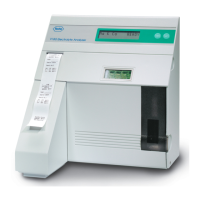Roche Diagnostics
Instructions for Use · Version 10.0 157
9180 Electrolyte Analyzer 10 Troubleshooting
Troubleshooting
Conditioning fluid not
detected
Under certain conditions, the analyzer may
not detect the presence of
Sodium Electrode Conditioner
o Air bubbles in the
Sodium Electrode Conditioner
o Not enough
Sodium Electrode Conditioner
o Sodium Electrode Conditioner is not
aspirated properly through the sampling
mechanism.
o Ensure that the o-rings are in the correct position and
sealing the electrodes.
o Check the aspiration of the
Sodium Electrode Conditioner and see if there are clots
in the sampling mechanism.
o Ensure that the pump windings are properly sealed.
o Ensure that the sample sensor is plugged in and test the
sample sensor to verify that it is operating correctly.
(Testing the sample sensor (p. 160))
Check electrodes The electrodes are not calibrated for one of
the following reasons:
o A stable reading of Standard A solution
could not be obtained within
6 aspirations.
o The slope A-B or A-C is out of range.
o Ensure that the electrodes are properly plugged in.
o Check for proper operation of the reference electrode
assembly. If necessary, clean the reference electrode
housing (Cleaning the reference electrode housing
(p. 137)) or replace the reference electrode (Replacing
electrodes (p. 143)).
o Perform daily maintenance. (Daily maintenance
(p. 133))
o Replace the SnapPak. (Checking reagent fluid level and
changing the SnapPak (p. 145))
Clog check fluid path A defective reference housing (increased
discharge of KCl) does not allow the sample
path to clear or aspirate any of the 3 standard
solutions at the beginning of a calibration.
o Ensure that the o-rings are in the correct position and
sealing the electrodes.
o Make sure that there are no leaks in the fluid path.
o Check for a clog or crystallization in the fluid path,
especially in the sample probe, in the tubing up to the
sample sensor and in the sample sensor.
o Ensure that the sample sensor is securely plugged in
and perform a sample sensor test to ensure that the
sensor is operating correctly. If necessary, clean the
sample sensor. (Testing the sample sensor (p. 160))
o Replace the reference electrode housing.
o Perform a calibration to remove the error message.
o Check the peristaltic pump tube set.
The concentration of the sample is outside of
the measurement range (Specifications
(p. 33)).
o In the case of a urine sample, arrows up instead of the
K
+
-result indicate that further dilution of the sample is
necessary (Urine samples (p. 111)).
o Check for proper sample preparation (Measurement
(p. 97)).
o Check for small air bubbles in the sample after
aspiration into the sample chamber.
o Check for proper aspiration of Standard A solution.
With Ca
2+
activated, arrows up or down are
displayed if the temperature is out of range
(Range 10.0°C - 40°C). The temperature
sensor is located in the right side electrode
holder.
o Ensure that the sample sensor cable is securely plugged
in.
o Make sure that the room temperature is within the
specified limits (15°C to 32°C / 60°F to 90°F).
o Test the amplifier to measure the actual temperature.
(Testing the amplifier (p. 162))
o With the front door open, the temperature displayed
should be about 5°C above room temperature.
Err. No valid voltage reading was obtained from
the electrode.
o Check for proper sample preparation (Measurement
(p. 97)).
o Check if the electrode holder is locked in the back
position.
o Check for proper filling of the reference housing.
o Check for air bubbles in the sample.
Message Cause Action
Table 10-1

